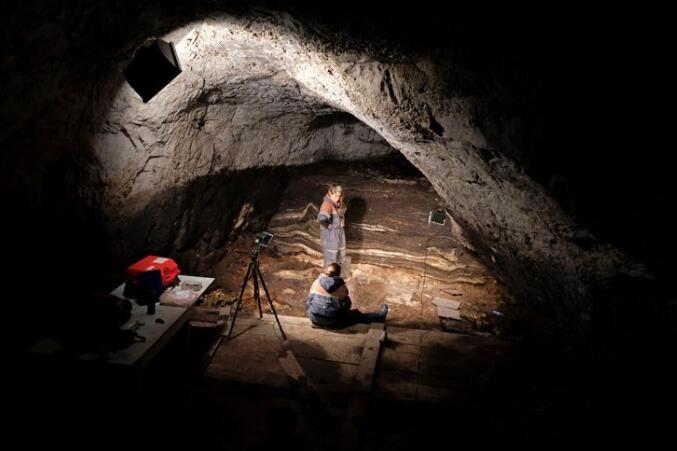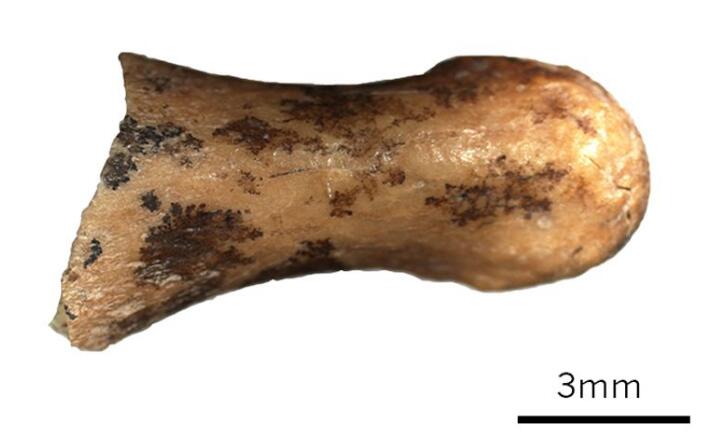Lost Denisovan bone reveals surprisingly human-like finger
A new analysis of a finger bone used to study the Denisovans — a group of ancient humans identified in 2010 — offers clues to a decade-long mystery surrounding one the most important hominin fossils ever found.
The study describes the tip of a right-hand little finger, which was separated from the rest of the finger bone after it was excavated 11 years ago. A digital reconstruction of the complete finger bone, or phalanx, reveals that the Denisovans’ fingers were much more similar to those of modern humans than expected.

Bones belonging to ancient hominins have been discovered in the Denisova Cave in Siberia’s Altai mountains.Credit: Eddie Gerald/Alamy
“I’m happy that we could get something out,” says Eva-Maria Geigl, a palaeogeneticist at the Institute Jacques Monod in Paris, who co-led the study. “So far there was nothing, as if the phalanx was lost.”
Her team sequenced DNA from the missing fragment to show that it matched the rest of the fingertip bone, and used photographs to reunite the two pieces digitally. The work was published on 4 September in Science Advances1.
“It’s not going to revolutionize our knowledge of Denisovan morphology, but it adds a little piece,” says Bence Viola, a palaeoanthropologist at the University of Toronto in Canada who was part of the team.
Denisovan discovery
The mystery surrounding the lost piece began in a remote valley at the foot of the Altai Mountains in southern Siberia, where Russian archaeologists excavating the Denisova Cave uncovered a finger bone belonging to a group of ancient humans in 2008. Anatoly Derevianko, who is an archaeologist at the Russian Academy of Sciences Institute of Archeology and Ethnography in Novosibirsk and was leading the dig, decided to divide the bone and send the pieces to two labs to see whether DNA could be extracted from either half.
One of the fragments went to Svante Pääbo, an evolutionary geneticist at the Max Planck Institute for Evolutionary Anthropology in Leipzig, Germany. His team sequenced its DNA and discovered that the bone belonged to a lineage distinct from modern humans and from Neanderthals. In January 2010, Pääbo and several of his colleagues flew to Novosibirsk.
That’s when Derevianko told Pääbo’s team that he had divided the bone in two and sent the other half to Edward Rubin, a geneticist then at Lawrence Berkeley National Laboratory (LBNL) in California, whose team had been competing with Pääbo’s to sequence Neanderthal DNA.
“We freaked out a bit,” remembers Viola, who joined Pääbo on the trip. “We had no idea there was this second part.”
Worried about getting scooped, Pääbo and his team raced to report their discovery. They published the fossil’s mitochondrial genome — a short stretch of maternally inherited DNA — in March 20102. Several months later, they went on to reveal the first complete nuclear genome of a Denisovan3. The studies showed that Denisovans were a group of extinct hominins that were more closely related to Neanderthals than to modern humans, and that they lived in the Siberian cave — and probably across Asia — more than 30,000 years ago.

The whereabouts of the missing bone fragment are still unclear.Credit: Eva-Maria Geigl
The 2010 finding transformed the cave into one of the world’s most important archaeological sites. Researchers have since found more ancient-human bones in the cave, including the stunning discovery of a first-generation hybrid, which had a Neanderthal mother and Denisovan father.
But Viola — who has analysed nearly every Denisovan fossil from the cave — says he never forgot about the second finger-bone fragment. “I’ve been wondering the whole time what the other half would have looked like,” he says. “All I knew is that it was in Berkeley.”
Revisiting old bones
According to Geigl, Rubin, who left the LBNL in 2016 for industry and could not be reached for comment, sent his half of the fossil to her lab in 2010. Pääbo’s team had already published the fossil’s mitochondrial genome. But Geigl hoped to obtain nuclear DNA from the fossil, which could indicate much more about the hominin’s relationship to humans and Neanderthals.
Initial efforts to extract DNA from the bone failed, so Geigl’s team worked on developing other methods. But after Pääbo's team published the Denisovan nuclear genome, Rubin asked Geigl to return the fossil. She returned the fragment in 2011, but was able to sample its DNA and take detailed photographs first.
Geigl sat on the data for years, but in 2016, she decided to publish them, at the suggestion of Pääbo. Her team sequenced the mitochondrial genome and discovered — unsurprisingly — that it exactly matched the sequence Pääbo’s team had published in 2010. But a digital reconstruction of the complete finger bone held a surprise: the bone was slim, and more like the fingers of modern humans than the stout digits of Neanderthals, even though Denisovans are more closely related to Neanderthals. The few other Denisovan remains that have been discovered, including large molar teeth, tend not to resemble those of modern humans.
“Given the limited skeletal remains definitively associated with Denisovans, this is an important discovery,” says Tracy Kivell, a palaeoanthropologist at the University of Kent, UK, who was not involved in the study. The slender shape of the Denisovan finger also suggests that Neanderthals’ burlier fingers might have evolved as a result of strenuous use of their hands, she adds.
Although the story of the missing fragment has become clearer, its current whereabouts are still unknown. According to Derevianko, Rubin sent the sample to the ancient-DNA lab of Eske Willerslev at the University of Copenhagen and the Natural History Museum of Denmark in 2011 or 2012. Willerslev did not respond to requests for comment by Nature’s news team.
Pääbo and his team had to grind up a portion of their piece of the bone to produce a high-quality genome sequence and returned the rest to Derevianko, but Geigl is unsure if the half she analysed is gone. “It’s like a Sherlock Holmes story,” she says.

